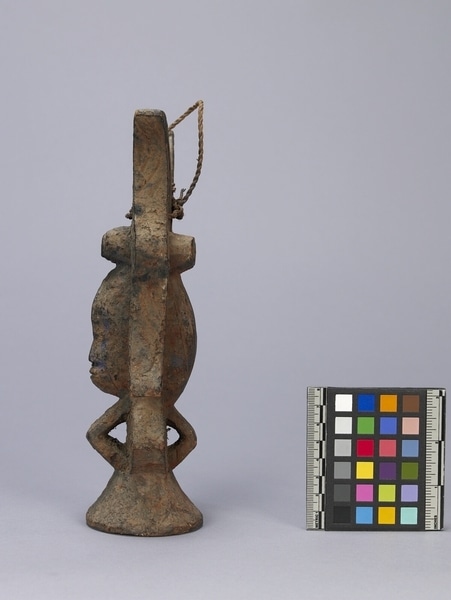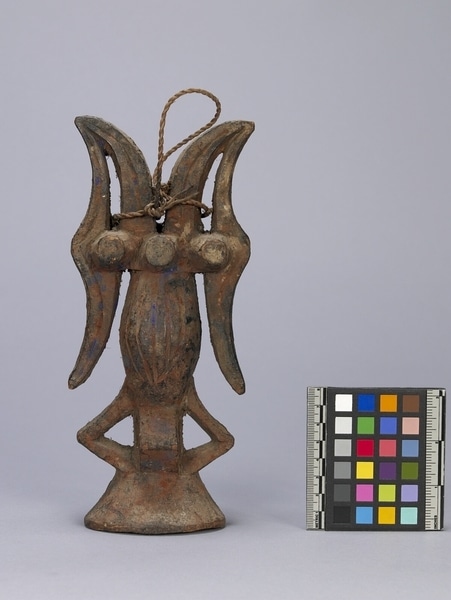Figure Item Number: Af332 from the MOA: University of British Columbia




Description
Ikenga statute in three sections on an oval pedestal with four angled protuberance rising above. On these, theree rests an elongated face forming the second section. Scarification marks are incised from corners of the mouth, and the cheeks. Back of head has five lines carved from the top of the head to the base, joining at that point. Third section is an elaborate headdress with large horns that curve away from the head. Flaring outwards slightly. Outside of horns are incised with three sets of wavy lines. Three knobs face forward and backward at the base of the headdress.Traces of indigo and ochre overall. A twisted fibre cord is tied around horns, with a loop at end. Has a circular base.
History Of Use
Ikenga (literally "strength of movement") is a horned spirit and one of the most powerful symbols for the Igbo people. Smaller figures were owned by individual men; larger ones were made for family and village shrines. Although taking on different forms, the figures always have a pair of ram’s horns, representing the animal’s strength and fortitude, characteristics like power, achievement and upward mobility, valued by men who regularly invoke them for success. Ikenga rarely stand alone; they appear on altars alongside other objects dedicated to chi or ndimmo (ancestors). This acknowledges achievements of individuals, as well as relationships with family and the creator. To affirm these relationships, the ensembles are given joint offerings. When ikenga do stand alone, sometimes in the sleeping quarters of their owners, the offerings they are given only acknowledge success in personal undertakings, such as hunting or trading expeditions. Annual feasts dedicated to ikenga provide further opportunity for the evaluation of personal achievement.
Item History
- Made in Nigeria before 1970
- Collected during 1970
- Owned by Alan R. Sawyer and Erika H. Sawyer before May 1, 1977
- Received from Alan R. Sawyer (Donor) and Erika H. Sawyer (Donor) on May 1, 1977
What
- Name
- Figure
- Identification Number
- Af332
- Type of Item
- figure
- Material
- wood, fibre, indigo pigment and camwood pigment
- Manufacturing Technique
- carved
- Overall
- height 24.0 cm, width 11.0 cm, depth 6.0 cm
Who
- Culture
- Igbo
- Previous Owner
- Alan R. Sawyer and Erika H. Sawyer
- Received from
- Alan R. Sawyer (Donor) and Erika H. Sawyer (Donor)
Where
- Holding Institution
- MOA: University of British Columbia
- Made in
- Nigeria
When
- Creation Date
- before 1970
- Collection Date
- during 1970
- Ownership Date
- before May 1, 1977
- Acquisition Date
- on May 1, 1977
Other
- Item Classes
- carvings & sculpture
- Condition
- good
- Accession Number
- 0350/0006